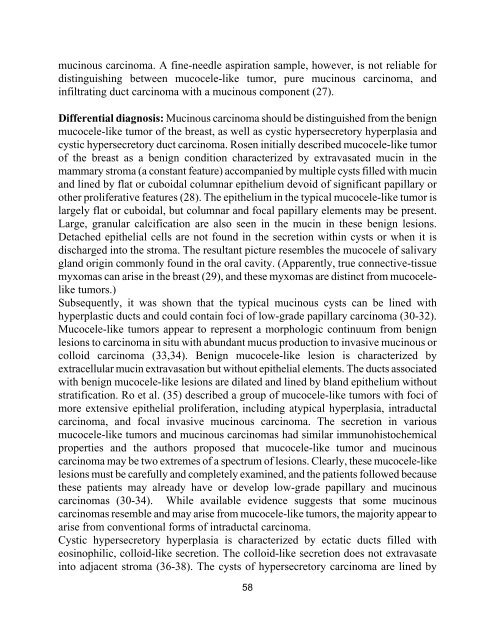33 Special Types of Invasive Breast Carcinoma: Diagnostic Criteria ...
33 Special Types of Invasive Breast Carcinoma: Diagnostic Criteria ...
33 Special Types of Invasive Breast Carcinoma: Diagnostic Criteria ...
You also want an ePaper? Increase the reach of your titles
YUMPU automatically turns print PDFs into web optimized ePapers that Google loves.
mucinous carcinoma. A fine-needle aspiration sample, however, is not reliable for<br />
distinguishing between mucocele-like tumor, pure mucinous carcinoma, and<br />
infiltrating duct carcinoma with a mucinous component (27).<br />
Differential diagnosis: Mucinous carcinoma should be distinguished from the benign<br />
mucocele-like tumor <strong>of</strong> the breast, as well as cystic hypersecretory hyperplasia and<br />
cystic hypersecretory duct carcinoma. Rosen initially described mucocele-like tumor<br />
<strong>of</strong> the breast as a benign condition characterized by extravasated mucin in the<br />
mammary stroma (a constant feature) accompanied by multiple cysts filled with mucin<br />
and lined by flat or cuboidal columnar epithelium devoid <strong>of</strong> significant papillary or<br />
other proliferative features (28). The epithelium in the typical mucocele-like tumor is<br />
largely flat or cuboidal, but columnar and focal papillary elements may be present.<br />
Large, granular calcification are also seen in the mucin in these benign lesions.<br />
Detached epithelial cells are not found in the secretion within cysts or when it is<br />
discharged into the stroma. The resultant picture resembles the mucocele <strong>of</strong> salivary<br />
gland origin commonly found in the oral cavity. (Apparently, true connective-tissue<br />
myxomas can arise in the breast (29), and these myxomas are distinct from mucocelelike<br />
tumors.)<br />
Subsequently, it was shown that the typical mucinous cysts can be lined with<br />
hyperplastic ducts and could contain foci <strong>of</strong> low-grade papillary carcinoma (30-32).<br />
Mucocele-like tumors appear to represent a morphologic continuum from benign<br />
lesions to carcinoma in situ with abundant mucus production to invasive mucinous or<br />
colloid carcinoma (<strong>33</strong>,34). Benign mucocele-like lesion is characterized by<br />
extracellular mucin extravasation but without epithelial elements. The ducts associated<br />
with benign mucocele-like lesions are dilated and lined by bland epithelium without<br />
stratification. Ro et al. (35) described a group <strong>of</strong> mucocele-like tumors with foci <strong>of</strong><br />
more extensive epithelial proliferation, including atypical hyperplasia, intraductal<br />
carcinoma, and focal invasive mucinous carcinoma. The secretion in various<br />
mucocele-like tumors and mucinous carcinomas had similar immunohistochemical<br />
properties and the authors proposed that mucocele-like tumor and mucinous<br />
carcinoma may be two extremes <strong>of</strong> a spectrum <strong>of</strong> lesions. Clearly, these mucocele-like<br />
lesions must be carefully and completely examined, and the patients followed because<br />
these patients may already have or develop low-grade papillary and mucinous<br />
carcinomas (30-34). While available evidence suggests that some mucinous<br />
carcinomas resemble and may arise from mucocele-like tumors, the majority appear to<br />
arise from conventional forms <strong>of</strong> intraductal carcinoma.<br />
Cystic hypersecretory hyperplasia is characterized by ectatic ducts filled with<br />
eosinophilic, colloid-like secretion. The colloid-like secretion does not extravasate<br />
into adjacent stroma (36-38). The cysts <strong>of</strong> hypersecretory carcinoma are lined by<br />
58


